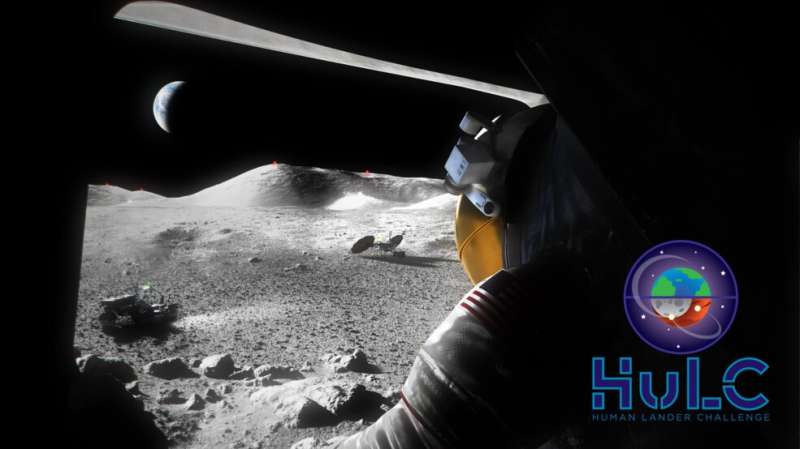This article has been reviewed according to Science X's editorial process and policies. Editors have highlighted the following attributes while ensuring the content's credibility:
fact-checked
trusted source
proofread
NASA seeks student ideas for moon landing dust control

As NASA and industry partners develop new human landing systems to transport astronauts from lunar orbit to the moon's surface and back as part of Artemis, the agency is asking university students to investigate solutions to one particularly dusty aspect of landing spacecraft on the lunar surface.
NASA's new Human Lander Challenge invites college students to explore ways to manage or prevent the cloud of dust a spacecraft stirs up when using rocket engines to land on unprepared surfaces like the moon. This effect is called plume surface interaction and can increase risks caused by lunar dust on future human missions.
"The moon is covered with granular, rocky material called regolith, which can be lifted from the surface by rocket engines during landing and ascent. Understanding and reducing these effects are key challenges for NASA to overcome for safe lunar surface access," said Ashley Korzun, principal investigator for plume surface interaction, NASA's Langley Research Center in Hampton, Virginia. "Besides creating a more challenging landing environment, disturbed lunar dust also can damage other assets NASA plans to establish on the moon's surface, like habitats, mobility systems, scientific experiments, and other critical infrastructure."
To establish a long-term human presence on and around the moon for the benefit of humanity, NASA must address the challenges lunar dust presents to these complex missions. This is where the Artemis Generation of problem solvers may be able to help.
For the challenge, NASA is asking undergraduate and graduate students from accredited colleges and universities in the United States to help tackle the challenges of plumes and lunar dust by seeking innovative, systems-level solutions to minimize and manage the impacts on future lunar exploration systems. Potential solutions might include development of dust shields, creating flight instrumentation dedicated to managing plume surface interactions, finding ways to see through the dust cloud during landing, or tracking dust during ascent and descent.
NASA will select up to 12 teams to compete at the inaugural Human Lander Challenge Forum in June 2024 in Huntsville, Alabama. Each team will receive a $7,000 stipend to produce a technical paper and any associated design models or prototypes to present in a competitive design review to a panel of NASA and industry subject matter experts. The top three teams will share a total prize of $18,000, with the first-place team receiving $10,000, the second-place team receiving $5,000, and the third-place team receiving $3,000.
"It is our mission to have a lunar landing capability that allows astronauts to travel to the surface of the moon and back safely on a regular basis," said Lisa Watson-Morgan, manager, Human Landing Systems, NASA's Marshall Space Flight Center in Huntsville, Alabama. "The challenge of managing the dust stirred up by lunar landers is a top priority, so this is a great opportunity for students to work with NASA in advancing humanity's exploration of the moon's South Pole region under Artemis. We look forward to seeing what these teams come up with."
Teams interested in participating in the challenge should review competition guidelines and eligibility requirements. Teams are encouraged to submit a non-binding notice of intent by Oct. 22, 2023. Proposals are due March 4, 2024.
More information: For full competition details, visit the Human Lander Challenge website: https://hulc.nianet.org
Provided by NASA's Goddard Space Flight Center





















